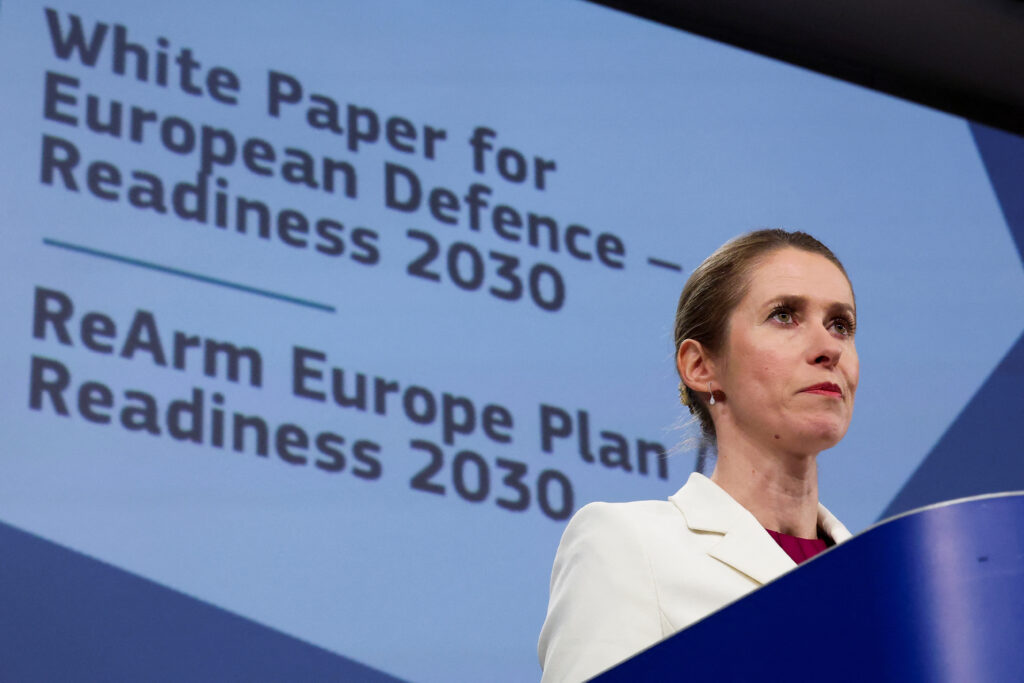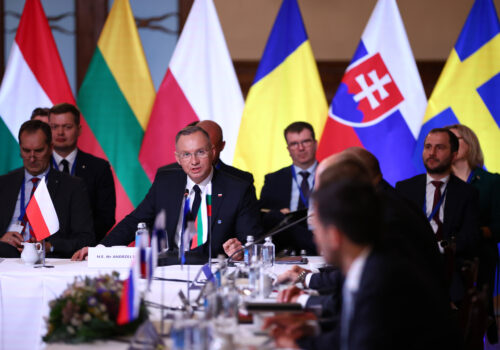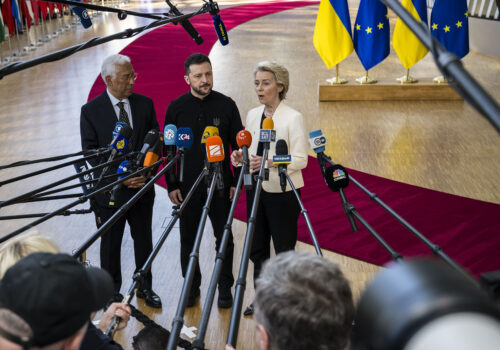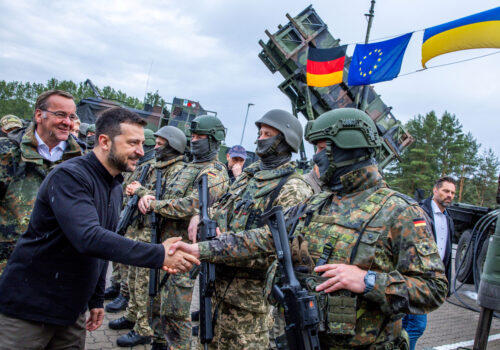The US-led talks aiming to end the war in Ukraine and efforts by France and Britain to stand up a “reassurance force” to provide a security guarantee to Kyiv have dominated headlines in the past few weeks. So it would have been easy to overlook the March 19 publication of the European Commission’s Joint White Paper for European Defence Readiness 2030. But this White Paper bears attention, as it marks a significant milestone in the European Union’s (EU’s) ongoing efforts to strengthen its security.
In December, European Commission President Ursula von der Leyen assigned Kaja Kallas, the EU’s top diplomat, and Andrius Kubilius, the first-ever commissioner for defense and space, to produce this document. The resulting text presents a roadmap for Europe to build up its defense capabilities in response to growing external security threats, including the possibility of Russian military aggression against EU territory. The White Paper also represents a direct reaction and message to the ongoing changes in Washington’s approach to European security under US President Donald Trump.
The White Paper adopts a five-year outlook, which is also the timeframe in which several European intelligence agencies have estimated Moscow would require to reconstitute its military capabilities such that it could conduct a large-scale attack on a NATO country. In the event of a cease-fire or peace agreement with Ukraine, Russia would almost certainly seek to accelerate its rearmament. Meanwhile, Europe faces uncertainty regarding the extent of continued US security assistance given Washington’s rapidly shifting foreign policy stances and priorities.
The White Paper calls for addressing critical capability gaps, fostering a competitive defense industry, strengthening military support for Ukraine, and securing relevant financial instruments and resources for defense. But whether the EU will be able to address these challenges in the five-year window the report outlines will depend on member states’ willingness to make the necessary financial commitments and their ability to navigate political divisions within the bloc.
Filling capability gaps
The document begins by diagnosing Europe’s severe defense shortcomings. It explicitly states that Europe is currently ill-equipped to respond adequately to contemporary security challenges.
Major capability gaps are identified in the following areas:
- Air and missile defense
- Artillery systems
- Ammunition and missile production
- Drones and counter-drone systems
- Military mobility
- Artificial intelligence, quantum technologies, cyber, and electronic warfare
- Strategic enablers and critical infrastructure protection
It’s a big list, and to close these gaps the White Paper advocates for deeper collaboration among European nations on defense projects of common interest. It builds on EU reports from 2024 by former Finnish President Sauli Niinistö on civilian and military preparedness and by former European Central Bank President Mario Draghi on competitiveness, both of which highlighted inefficiencies and excessive costs resulting from a lack of coordination within the European defense industry.
So, what does this mean in practice? The White Paper specifically recommends harnessing “European economies of scale” and collaborative procurement to reduce costs, shorten delivery times, make demand more predictable for producers, and enhance interoperability.
A major question going forward, however, is how the EU’s efforts fit in with NATO. Importantly, capability building is an area in which EU collaboration can benefit the Alliance. EU countries share a single set of capabilities. If these capabilities are primarily defined by NATO, then the twenty-three EU member states that are also part of the Alliance would contribute to fulfilling them, including through EU instruments. For example, one of the major capacity building areas is military mobility, which particularly important for the EU countries that provide NATO host-nation support.
Strengthening the defense industry
In addition to capability gaps, the White Paper addresses structural weaknesses within the European defense industry, pinpointing fragmentation and underinvestment as major obstacles to achieving credible deterrence. Three years into the war in Ukraine, Europe remains unable to produce sufficient weapons and ammunition quickly. To remedy this, the document proposes creating a common European defense market, aggregating demand to increase predictability.
Another main focus is ensuring supply-chain security and reducing external dependencies. The commitment to collaboration is further reinforced by plans to simplify regulations. The European Commission pledged to launch a strategic dialogue with the defense industry and introduce the Defence Omnibus Simplification Proposal by June 2025. This act is intended to simplify the legal and administrative framework for procurements and industry cooperation. Excessive regulation has been a long-standing obstacle in this field, and streamlining administrative processes is overdue.
Prioritizing Ukraine
The White Paper states that Ukraine remains on the front line of European security and enhancing the EU’s defense requires continued military support to Kyiv. The report outlines what it calls a “Porcupine Strategy,” which is aimed at deterring further Russian aggression by equipping Ukraine with the necessary capabilities. This is the strongest security guarantee that Europe can provide to Kyiv.
The document highlights the following defense priorities for enhancing Europe’s military support for Ukraine:
- Provision of large-caliber artillery ammunition (with a target of two million rounds in 2025)
- Deployment of air defense systems
- Enhanced drone capabilities
- Continued military training
Despite Kallas’s initial ambition for a twenty billion euro military support package in 2025, her initiative has reportedly faced resistance from several member states, resulting in a more limited focus on ammunition supplies. This highlights the potential limitations that will complicate efforts to implement the plans outlined in the White Paper.
The document also calls for supporting Ukraine’s defense industry through direct contracts and closer integration with the European defense sector, including joint ventures. This effort should be further outlined in the forthcoming European Defence Industry Plan, expected within the next few months. Close cooperation with Ukraine in this domain is in Europe’s interest, as the bloc will benefit from Kyiv’s wartime experience and innovations. Such defense industry collaboration could also indirectly strengthen Ukraine’s EU membership prospects.
Securing new financial sources
Perhaps the most transformative element of the White Paper concerns defense financing. It builds upon the ReArm Europe Plan, unveiled by von der Leyen in early March.
The financial framework includes:
- Joint EU loans backed by the EU budget, branded as SAFE (Security and Action for Europe), with an initial ceiling of €150 billion
- An “escape clause” from the Stability and Growth Pact, allowing member states to exclude up to 1.5 percent of defense spending from national debt assessments
- Relaxation of existing EU funding rules, mobilization of private capital, and adjustments to European Investment Bank regulations
The overarching ambition is to generate up to €800 billion in defense funding.
Success will depend on how seriously member states approach the offer. Some may take advantage of the relaxation of the escape clause to finance projects that are only superficially linked to military objectives. There is also some uncertainty surrounding the SAFE instrument, which aims to increase member states’ investments in defense via loans. Some capitals may secure better interest rates in domestic markets than those offered by the EU. Others may prefer different cooperation frameworks. Fiscally cautious governments might even exclude loans as an option on principle. A true embarrassment for the EU would arise if a substantial number of capitals considering SAFE were to withdraw due to the instrument’s byzantine rules.
From paper to practice
Since the White Paper is a European Commission initiative, it does not require formal approval from member states. However, its implementation will hinge on their willingness to support concrete instruments that will be built on the White Paper’s findings.
The first high-level discussions will take place at the upcoming EU Defense Ministers’ meeting on April 2-3, followed by the Foreign Affairs Council meeting on April 14. The goal is to secure agreement on key measures—such as SAFE and the Defence Omnibus Simplification Proposal—by June’s EU leaders’ summit.
A white paper, not a silver bullet
EU financial tools and incentives—aiming to generate €800 billion—certainly have the potential to move things forward, but they are not a silver bullet. A comprehensive response to the defense and security challenges Europe faces requires a multipronged approach to funding, with a majority of resources coming from member states. This will require significant increases in member states’ defense spending, likely beyond the currently discussed figure of 3 percent of each country’s gross domestic product. The mobilization of private capital should also be considered as part of this mix.
The success of the White Paper’s recommendations will also depend on the unity of the EU. Hungary, which has repeatedly blocked proposals for further military support to Ukraine, will not be the only obstacle to consensus on these initiatives. Take, for example, the prolonged discussions surrounding the upcoming European Defence Industry Plan, with the question of non-EU country participation emerging as a significant stumbling block. If increasing obstacles put EU security at greater risk, then one could expect a growing willingness to move forward instead in a “coalition of the willing,” which would further diminish the Commission’s coordination and support work.
Five years—the period in which a potential Russian threat to the EU could materialize—is a brief timeframe for Europe’s rearmament. For the sake of the EU and, in the more immediate term, of Ukraine, Europeans need to move from identifying the problems to acting on them. The White Paper is a good beginning, indicating a positive change in the mindset of EU policymakers, but the bloc must now translate this spirit into swift implementation.
Petr Tůma is a nonresident senior fellow at the Atlantic Council’s Europe Center. He is a Czech career diplomat with expertise on Europe, the Middle East, and transatlantic relations. His views are his own.
Further reading
Thu, Mar 20, 2025
As the US steps back in Europe, Central Europe must step up
New Atlanticist By Sona Muzikarova
The West’s security architecture is being redrawn. The question is whether it will be drawn by European powers or for them.
Thu, Mar 6, 2025
How European leaders are responding to Trump’s approach to Ukraine and Europe
New Atlanticist By
From London and Berlin to Paris and Brussels, European leaders have taken several notable steps this week on security. This follows the blow-up between the Ukrainian and US presidents on February 28.
Wed, Mar 5, 2025
How Europe wants to rearm itself
New Atlanticist By
Ahead of an important European Union (EU) meeting on March 6, plans are in development at both the EU and member state levels to boost defense spending.
Image: High Representative for Foreign Affairs and Security Policy and Vice-President of the European Commission Kaja Kallas looks on as she presents the white paper on the future of European defence, in Brussels, Belgium March 19, 2025. REUTERS/Yves Herman.



